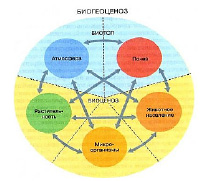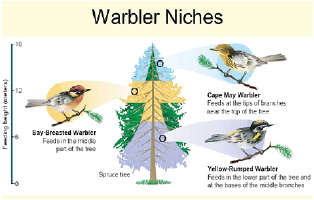
Научная электронная библиотека
Монографии, изданные в издательстве Российской Академии Естествознания
Chapter 4. ECOTOPE. ECOLOGICAL NICHE. HABITAT
|
Essential targets: By the end of this chapter you should be able to: discuss about the concept of an ecotope; distinguish an ecological niche and a habitat. |
Read the given text. Divide the text into three parts. Make the flowcharts for each part. Explain your results / Мәтінді оқып шығыңдар. Мәтінді үш бөлікке бөліңдер. Әрбір бөлік үшін блок-сызба құрастырыңдар / Прочитайте текст. Разделите текст на три части. Составьте блок-схемы для каждой части.
Ecotopes are the smallest ecologically distinct landscape features in a landscape mapping and classification system. As such, they represent relatively homogeneous, spatially explicit landscape functional units that are useful for stratifying landscapes into ecologically distinct features for the measurement and mapping of landscape structure, function and change [1].
Like ecosystems, ecotopes are identified using flexible criteria, in the case of ecotopes, by criteria defined within a specific ecological mapping and classification system. Just as ecosystems are defined by the interaction of biotic and abiotic components, ecotope classification should stratify landscapes based on a combination of both biotic and abiotic factors, including vegetation, soils, hydrology, and other factors. Other parameters that must be considered in the classification of ecotopes include their period of stability (such as the number of years that a feature might persist), and their spatial scale (minimum mapping unit) [2].

Pic. 1. Arthur Tansley [3]
The first definition of ecotope was made by Thorvald Sørensen in 1936. Arthur Tansley picked this definition up in 1939 and elaborated it (Pic.1). He stated that an ecotope is “thсe particular portion, of the physical world that forms a home for the organisms which inhabit it”. In 1945 Carl Troll first applied the term to landscape ecology “the smallest spatial object or component of a geographical landscape”. Other academics clarified this to suggest that an ecotope is ecologically homogeneous and is the smallest ecological land unit that is relevant [2].
A niche is a term with a variety of meanings related to the behavior of a species living under specific environmental conditions [4]. The ecological niche describes how an organism or population responds to the distribution of resources and competitors (for example, by growing when resources are abundant, and when predators, parasites and pathogens are scarce) and how it in turn alters those same factors (for example, limiting access to resources by other organisms, acting as a food source for predators and a consumer of prey). “The type and number of variables comprising the dimensions of an environmental niche vary from one species to another [and] the relative importance of particular environmental variables for a species may vary according to the geographic and biotic contexts” [5].
The notion of ecological niche is central to ecological biogeography, which focuses on spatial patterns of ecological communities [6]. “Species distributions and their dynamics over time result from properties of the species, environmental variation..., and interactions between the two — in particular the abilities of some species, especially our own, to modify their environments and alter the range dynamics of many other species” [7]. Alteration of an ecological niche by its inhabitants is the topic of niche construction [8].
The majority of species exist in a standard ecological niche, sharing behaviors and adaptations similar to the other closely related species within the same broad taxonomic class, but there are exceptions. A premier example of a non-standard niche filling species is the flightless, ground-dwelling kiwi bird of New Zealand, which feeds on worms and other ground creatures, and lives its life in a mammal niche. Island biogeography can help explain island species and associated unfilled niches [9].
A habitat is an ecological or environmental area that is inhabited by a particular species of animal, plant, or other type of organism. The term typically refers to the zone in which the organism lives and where it can find food, shelter, protection and mates for reproduction, utilizing the qualities the species has adapted to survive within the ecology of the habitat. It is the natural environment in which an organism lives, or the physical environment that surrounds a species population [10].
A habitat is made up of physical factors such as soil, moisture, range of temperature, and light intensity as well as biotic factors such as the availability of food and the presence or absence of predators. Every organism has certain habitat requirements for the conditions in which it will thrive, but some are tolerant of wide variations while others are very specific in their requirements. A habitat is not necessarily a geographic area — for a parasitic organism it is the body of its host, part of the host’s body such as the digestive tract, or a cell within the host’s body [10].
Habitat types include polar, temperate, subtropical and tropical. The terrestrial vegetation type may be forest, steppe, grassland, semi-arid or desert. Freshwater habitats include marshes, streams, rivers, lakes, ponds and estuaries, and marine habitats include salt marshes, the coast, the intertidal zone, reefs, bays, the open sea, the sea bed, deep water and submarine vents [10].
Habitats change over time. This may be due to a violent event such as the eruption of a volcano, an earthquake, a tidal wave, a bushfire or a change in oceanic currents. Or the change may be more gradual over millennia with alterations in the climate, as ice sheets and glaciers advance and retreat, as different weather patterns bring changes of precipitation and solar radiation. Other changes come as a direct result of human activities; deforestation, the ploughing of ancient grasslands, the diversion and damming of rivers, the draining of marshland and the dredging of the seabed. The introduction of alien species can have a devastating effect on native wildlife, through increased predation, through competition for resources or through the introduction of pests and diseases to which the native species have no immunity [10].
Glossary of essential terms / Негізгі терминдер глоссарийі / Глоссарий основных терминов
|
№ |
English term |
Kazakh equivalent |
Russian equivalent |
|
1 |
alien |
бөтен |
чужеродный |
|
2 |
alteration |
өзгеріс |
изменение |
|
3 |
bay |
шығанақ |
залив |
|
4 |
coast |
жаға |
побережье |
|
5 |
currents |
ағын |
течение |
|
6 |
draining |
құрғату |
осушение |
|
7 |
earthquake |
зілзала |
землетрясение |
|
8 |
estuary |
өзен сағасы |
устье реки |
|
9 |
homogeneous |
бірқалыпты |
однородный |
|
10 |
majority |
көбісі |
большинство |
|
11 |
mapping |
картаға түсіру |
картографирование |
|
12 |
marsh |
батпақ |
болото |
|
13 |
measurement |
өлшеу |
измерение |
|
14 |
moisture |
ылғал |
влажность |
|
15 |
relevant |
өзекті |
актуальный |
|
16 |
shelter |
пана |
укрытие |
|
17 |
stream |
бұлақ |
ручей |
|
18 |
surrounding |
орта |
окружение |
|
19 |
view |
көрініс |
пейзаж |
|
20 |
wave |
толқын |
волна |
|
21 |
worm |
құрт |
червь |
|
Questions: What are the components of an ecotope? What are the differences between a habitat and a niche? What habitat types are there? |
Key phrases and sentences / Түйінді сөздер мен сөйлемде / Ключевые фразы и предложения
1. The term «…» means … / «…» термині … білдіреді / Термин «…» означает …
2. The term “…” was introduced by … in … / “…” термині ... ж. ...енгізілді/ Термин «…» был введен … в … году.
3. Examples of an ecotope can be … / Экотопқа төмендегілер мысал бола алады: …/ Примерами экотопа могут быть: …
4. An ecological niche is a …/ Экологиялық тауаша дегеніміз …/ Экологическая ниша – это …
5. There are the following habitat types: …/ Таралу аймағының келесі түрлерін ажыратады: …/ Различают следующие типы ареалов: …
I. Translate the content of a block diagram into English. Give the definitions for the terms. Explain the scheme / Блок-сызбаның мазмұнын ағылшын тіліне аударыңдар. Терминдерге анықтама беріңдер, сызбаны түсіндіріңдер / Переведите содержание блок-схемы на английский язык. Дайте определения терминов. Объясните схему.

Figure 2. A block diagram of biogeocenosis (by V.N.Sukachev)
II. True or False / Шын немесе жалған / Правда или ложь.
|
True |
False |
|
|
Definitions of ecological niche and habitat are same. |
||
|
Ecotope is a complex of only abiotic factors. |
||
|
The term “Ecotope” was introduced by Thorvald Sørensen in 1936. |
||
|
Human activities change the habitats. |
||
|
A habitat is made up of biotic and abiotic factors. |
||
|
The body of host is a habitat for a parasitic organism. |
||
|
The dimensions of an environmental niche vary according to the geographic and biotic contexts. |
III. Match Habitats and following animals: house mouse, lion, antelope, a lizard, a shark, frog, parrot, polar bear, sheep, cow, deer, owl, viper, wolf, fox. Give the samples of plants for each habitat / Тіршілік ортасы және жануарлардың келесі түрін сәйкестендіріңдер: үй тышқаны, арыстан, антилопа, кесіртке, акула, көлбақа, тотықұс, ақ аю, қой, сиыр, бұғы, жапалақ, сұр жылан, қасқыр, түлкі. әрбір тіршілік ортасына өсімдіктер мысалын келтіріңдер / Соотнесите местообитания и следующие виды животных: домовая мышь, лев, антилопа, ящерица, акула, лягушка, попугай, белый медведь, овца, корова, олень, сова, гадюка, волк, лиса. Приведите примеры растений для каждой среды обитания.
|
Habitats |
Animals |
Plants |
|
|
||
|
|
||
|
|
||
|
|
||
|
|
||
|
|
||
|
|
||
|
|
IV. Look at the picture. How can three species of warbler birds live on the one tree? Can you have two separate organisms occupying the same exact niche? Give examples of ecological niches / Суретті қарап шығыңдар. ән салатын үш құс бір ағашта қалай тіршілік ете алады? Екі түрлі ағза бір қуыста тіршілік ететіндей мысал келтіре аласыңдар ма? Экологиялық қуыстардың мысалын келтіріңдер / Рассмотрите картинку. Как три вида певчих птиц могут жить на одном дереве? Можете привести пример, когда два разных организма занимают одну и ту же нишу? Приведите примеры экологических ниш.

Figure 3. Warbler niches [11]
V. Draw the scheme of an ecotope transformation under human activities in a biocenosis / Адамның биоценоздағы әрекетінің нәтижесіндегі экотоптың өзгеру сызбасын суретке салып беріңдер / Нарисуйте схему изменения экотопа в результате деятельности человека в биоценозе.
|
SUMMARY Ecotope – the biotope, the inert environment of the ecosystem, the sum of its abiotic components. Ecotopes are the smallest ecologically distinct landscape features in a landscape mapping and classification system. An ecological niche is a term describing the relational position of a species or population in an ecosystem. The description of a niche may include descriptions of the organism’s life history, habitat, and place in the food chain. According to the competitive exclusion principle, no two species can occupy the same niche in the same environment for a long time. A habitat is an ecological or environmental area that is inhabited by a particular species of animal, plant, or other type of organism. |
 Topics for essay:
Topics for essay:
1. Water as a habitat of living organisms.
2. Extreme habitats.
3. Microhabitats.
4. Habitat change and disturbance.
5. The underground habitat.
6. Habitat protection (legislations, treaties).
7. Factors of habitats (oxygen, light, temperature, etc.).
8. The desert as a natural area.
9. The forest as a natural habitat.
10. The principle of competitive exclusion (Gause’s principle).
 References:
References:
1. What are ecotopes? // http://ecotope.org/about/ecotopes/
2. Ecotope // http://en.wikipedia.org/wiki/Ecotope
3. Inside the ecosystem // http://www.geocities.ws/jacklynn/website/history.html
4. Three variants of ecological niche are described by Thomas W Schoener (2009). “§I.1 Ecological niche”. In Simon A. Levin; Stephen R. Carpenter; H. Charles J. Godfray; Ann P. Kinzig; Michel Loreau; Jonathan B. Losos; Brian Walker; David S. Wilcove. The Princeton Guide to Ecology. Princeton University Press. pp. 3 ff. ISBN 9781400833023.
5. A Townsend Peterson; Jorge Soberôn; RG Pearson; Roger P Anderson; Enrique Martínez-Meyer; Miguel Nakamura; Miguel Bastos Araújo (2011). “Species-environment relationships”. Ecological Niches and Geographic Distributions (MPB-49). Princeton University Press. p. 82. ISBN 9780691136882. See also Chapter 2: Concepts of niches, pp. 7 ff
6. Mark V. Lomolino; Brett R. Riddle; James H. Brown (2009). “The geographic range as a reflection of the niche”. Biogeography (3rd ed.). Sunderland, Mass: Sinauer Associates. p. 73. ISBN 978-0878934867. The geographic range of a species can be viewed as a spatial reflection of its niche Viewable on line via Amazon’s ‘look-inside’ feature.
7. Mark V. Lomolino; Brett R Riddle; James H. Brown (2009). “Areography: Sizes, shapes and overlap of ranges”. Biogeography (3rd ed.). Sunderland, Mass: Sinauer Associates. p. 579. ISBN 978-0878934867. Viewable on line via Amazon’s ‘look-inside’ feature.
8. A. Townsend Peterson; Jorge Soberôn; R.G. Pearson; Roger P. Anderson; Enrique Martínez-Meyer; Miguel Nakamura; Miguel Bastos Araújo (2011). “Major themes in niche concepts”. Ecological Niches and Geographic Distributions (MPB-49). Princeton University Press. p. 11. ISBN 9780691136882. We will make the crucial distinction between variables that are dynamically modified (linked) by the presence of the species versus those that are not. ... [Our construction] is based upon variables not dynamically affected by the species...in contrast to...those that are subject to modification by niche construction.
9. Ecological niche // https://en.wikipedia.org/wiki
10. Habitat // https://en.wikipedia.org/wiki
11. Warbler niches // http://slideplayer.com/slide/4486908/








